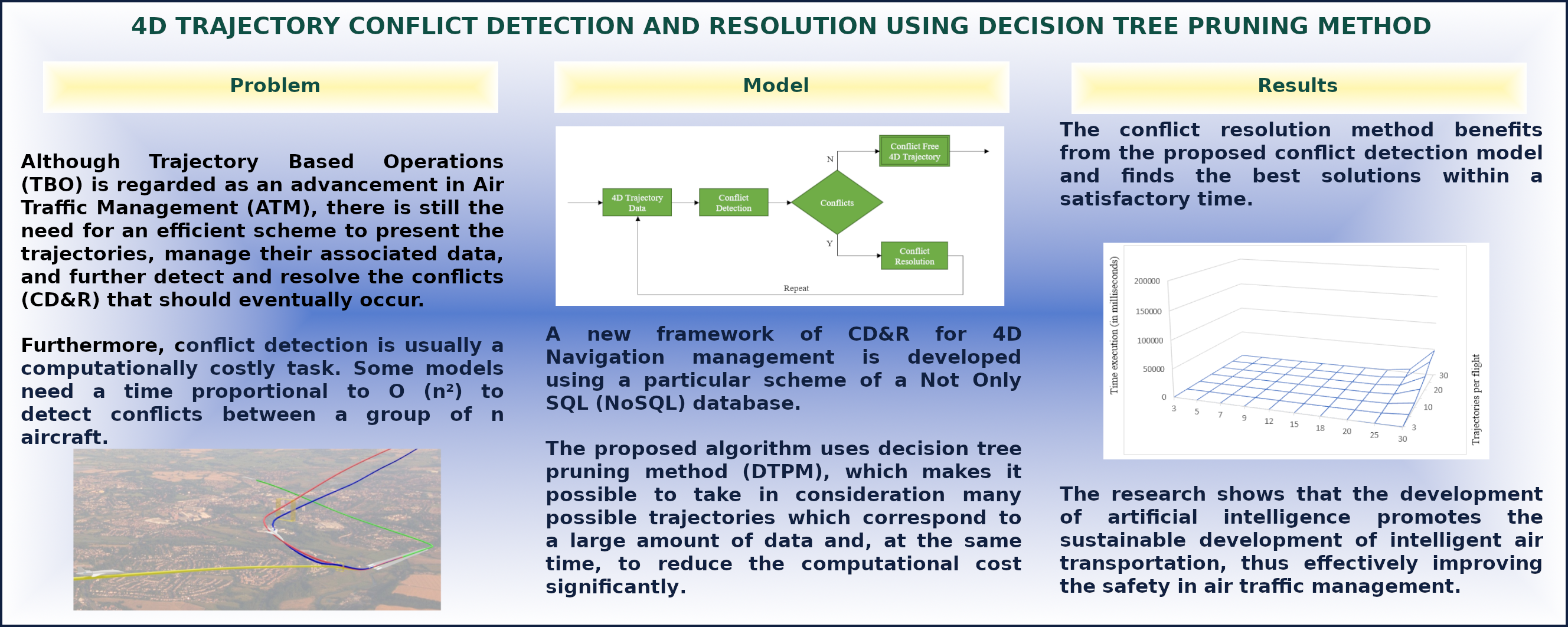4D Trajectory Conflict Detection and Resolution Using Decision Tree Pruning Method
Keywords:
4-Dimensional Trajectory, Conflict Detection and Resolution, Decision Tree Pruning Method, Not Only SQLAbstract
The aviation community develops Trajectory Based Operations (TBO) as an advancement in Air Traffic Management (ATM). There is still the need for an efficient scheme to present the trajectories, manage their associated data, and further detect and resolve the conflicts (CD&R) that should eventually occur. In this research, we develop a CD&R framework for managing predicted 4-Dimensional Trajectory (4DT). Using Not Only SQL (NoSQL) database (Cassandra and MongoDB), the 4D trajectories of related routes are presented, and the possible conflicts are detected using the strategy of Computing in NoSQL Database. Compared with other conflict detection algorithms, usually by the pairwise method with O(n2) at least, the proposed Decision Tree Pruning Method (DTPM) effectively treats massive data sets. The 4DT data are collected by Trajectory Predictor (TP) concerning 58% of the whole Brazilian air traffic. The comparison results between Cassandra and MongoDB from the case studies show the effectiveness of the proposed methods for conflict detection. In addition, we prove that the conflict resolution approach is viable for application in real scenarios, finding near-optimal solutions for the conflicts identified by the framework. Finally, we also demonstrated the development of sustainable artificial intelligence in intelligent air transportation to improve safety in air traffic management.
Downloads
References
J. E. Dieudonne, H. L. Crane, S. R. Jones, C. J. Smith, S. A. Remillard, and G. Snead, “Neo (nextgen 4d tm) provided by swim’s surveillance soa (sdn asp for rnp 4d ops),” in 2007 Integrated Communications, Navigation and Surveillance Conference, pp. 1–12, April 2007.
A. Rodríguez-Sanz, D. Álvarez, F. Comendador, R. Valdés, J. Pérez- Castán, and M. Godoy, “Air traffic management based on 4d trajectories: A reliability analysis using multi-state systems theory,” Transportation Research Procedia, vol. 33, pp. 355 – 362, 2018. XIII Conference on Transport Engineering, CIT2018.
G. Frontera, J. Besada, A. Bernardos, E. Casado, and J. López-Leonés, “Formal intent-based trajectory description languages,” IEEE Transac- tions on Intelligent Transportation Systems, vol. 15, pp. 1550–1566, Aug 2014.
M. Vilaplana, E. Gallo, and F. Navarro, “Towards a formal language for the common description of aircraft intent,” 24th Digital Avionics Systems Conference, vol. 1, pp. 3.C.5–3.1–9, 2005.
J. K. Kuchar and L. C. Yang, “A review of conflict detection and resolution modeling methods,” IEEE Transactions on Intelligent Trans- portation Systems, vol. 1, no. 4, pp. 179–189, 2000.
Y.-J. Chiang, J. T. Klosowski, C. Lee, and J. S. Mitchell, “Geometric algorithms for conflict detection/resolution in air traffic management,” in Proceedings of the 36th IEEE Conference on Decision and Control, vol. 2, pp. 1835–1840, IEEE, 1997.
Z. Wang, M. Liang, D. Delahaye, and W. Wu, “Learning real trajectory data to enhance conflict detection accuracy in closest point of approach,” in USA/Europe Air Traffic Management Research and Development Seminar (ATM2019), pp. 1–8, 2019.
R. A. Paielli and H. Erzberger, “Trajectory specification for terminal airspace: Conflict detection and resolution,” Journal of Air Transporta- tion, vol. 27, no. 2, pp. 51–60, 2019.
J.Tang,“Conflictdetectionandresolutionforcivilaviation:Aliterature survey,” IEEE Aerospace and Electronic Systems Magazine, vol. 34, no. 10, pp. 20–35, 2019.
S.Ruiz,M.Piera,J.Nosedal,andA.Ranieri,“Strategicde-conflictionin the presence of a large number of 4d trajectories using a causal modeling approach,” Transportation Research Part C: Emerging Technologies, vol. 39, pp. 39:129–147, 2014.
S. Ayhan, P. Costas, and H. Samet, “Prescriptive analytics system for long-range aircraft conflict detection and resolution,” in 26th ACM SIGSPATIAL International Conference on Advances in Geographic Information Systems, pp. 239 – 248, Nov 2018.
G. G. N. Sandamali, R. Su, K. L. K. Sudheera, Y. Zhang, and Y. Zhang, “Two-stage scalable air traffic flow management model under uncertainty,” IEEE Transactions on Intelligent Transportation Systems, vol. 22, no. 12, pp. 7328–7340, 2021.
R. Sabatini, A. Gardi, K. D. Ridder, S. Ramasamy, and L. Salazar, “Automated intent negotiation and validation system for 4-dimensional trajectory based operations,” in European Navigation Conference (ENC), p. pp, 04 2013.
K.quanCai,Y.wuTang,andW.Wang,“Anevolutionarymulti-objective approach for network-wide conflict-free flight trajectories planning,” in 2015 IEEE/AIAA 34th Digital Avionics Systems Conference (DASC), pp. 1D2–1–1D2–10, Sep 2015.
J. Rosenow, M. Lindner, and J. Scheiderer, “Advanced flight planning and the benefit of in-flight aircraft trajectory optimization,” Sustainabil- ity, vol. 13, no. 3, 2021.
I.R.DeOliveira,V.F.Ribeiro,L.Weigang,andR.C.Garcia,“Detecting violation of aircraft separation requirements,” Feb. 4 2020. US Patent 10,553,121.
J. Besada, G. Frontera, J. Crespo, E. Casado, and J. López-Leonés, “Automated aircraft trajectory prediction based on formal intent-related language processing,” IEEE Transactions on Intelligent Transportation Systems, vol. 14, Sep 2013.
EUROCONTROLandFAA,“Commontrajectorypredictorstructureand terminology,” Tech. Rep. Version 1.0, Action Plan 16 White Paper, Jan 29th 2010.
M. O. Ball, R. L. Hoffman, D. Knorr, J. Wetherly, and M. Wambsganss, “Assessing the benefits of collaborative decision making in air traffic management,” Progress in Astronautics and Aeronautics, vol. 193, pp. 239–252, 2001.
J. López-Leonés, M. A. Vilaplana, E. Gallo, F. A. Navarro, and C. Querejeta, “The aircraft intent description language: A key enabler for air-ground synchronization in trajectory-based operations,” in 2007 IEEE/AIAA 26th Digital Avionics Systems Conference, pp. 1.D.4–1– 1.D.4–12, Oct 2007.
R. E. Korf, Artificial Intelligence Search Algorithms, p. 22. Chapman amp; Hall/CRC, 2 ed., 2010.
DECEA, “Anuário estatístico de tráfego aéreo,” tech. rep., Headquarters of Air Navigation Management (CGNA), 2018.


